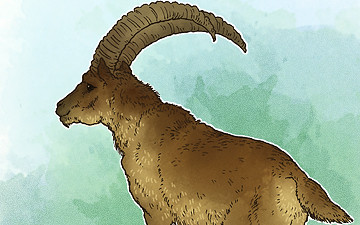The Alpine Ibex, Capra ibex, is a species of wild goat that lives in the mountains of the European Alps. The Spanish Ibex(Capra pyrenaica) and the Middle Eastern Nubian Ibex (Capra nubiana) are very close relatives of the Alpine Ibex.
Male specimens commonly grow to a height of about 1 metre (3 ft 3 in) and reach a weight of about 100 kilograms (220 lb). Females are usually only half the size of males. Apart from size, males can also be distinguished by their prominent beard. Older males will tend to grow beards under their chin.[clarification needed] Both male and female ibexes have large, backwards-curving horns although those of the male are substantially larger and can grow to an impressive length of up to 1 metre (3 ft 3 in). These horns are used to defend themselves from predators such as wolves, lynxes,bears and foxes. Small kids may also be susceptible to attacks from large predatory birds such as eagles. The Ibex has a brownish grey colouring in the summer which changes during the winter months to a richer, darker brown. It is related to the Nubian and Siberian ibexes.
Ibexes are strictly herbivorous and survive on a diet of grass, moss, flowers, leaves and twigs. If leaves and shoots are out of reach, Ibexes often stand on their rear legs to reach this food. They eat during late afternoon and evening hours, descending at this time from the high steep cliffs and into the lower alpine meadows below. The rest of the day is spent in the higher altitude of the cliffs and hills. This pattern of remaining at higher altitudes during the bright daylight hours helps protect them from predators who do not inhabit such high terrain. In the winter, Ibexes also tend to live at lower altitudes since food is more scarce. The need to drink every few days in the summer causes the Ibexes to seek permanent residence within proximity to a dependable water source during this season. If predators are after them, Ibexes will hide in the rocks of the steep cliffs.
(From Wikipedia, July 5th, 2010)
—
Females live in social hierarchies that consist of 10 – 20 females in a herd with one dominant female. Males live in smaller herds of about 6 – 8, until the fall when the males rut. During this time males become solitary and are aggressive to other males. Some males live solitary all year long. (Jordan, 1969; Nowak, 1999)
Alpine ibex are mountain animals usually living at elevations up to 3,200 meters. Males stay up on the rock cliffs during the day, whereas females stay below in the rolling slopes and brushy areas. At night they will all move down into the forest for the night to feed. (McGoldrick, 1997)
(From EOL via Animal Diversity Web)
—




